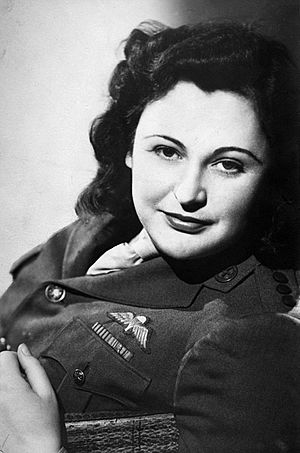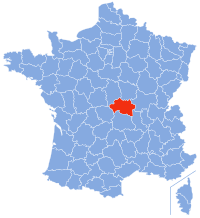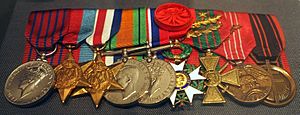Nancy Wake facts for kids
Quick facts for kids
Nancy Wake
|
|
|---|---|

Wake in 1945
|
|
| Nickname(s) | Hélène (SOE) Andrée (French Resistance/SOE Identity) White Mouse (Gestapo in France) |
| Born | 30 August 1912 Roseneath, Wellington, New Zealand |
| Died | 7 August 2011 (aged 98) London, England |
| Allegiance | |
| Service/ |
Special Operations Executive First Aid Nursing Yeomanry |
| Years of service | 1943–1945 (SOE) |
| Rank | Captain |
| Unit | Freelance |
| Battles/wars | Second World War |
| Awards | Companion of the Order of Australia George Medal Officer of the Legion of Honour (France) Croix de guerre (France) Médaille de la Résistance (France) Medal of Freedom (United States) RSA Badge in Gold (New Zealand) |
| Spouse(s) | Henri Fiocca (d. 1943) John Forward |
Nancy Grace Augusta Wake (born 30 August 1912 – died 7 August 2011) was a brave nurse and journalist. She became a spy and a leader in the French Resistance during World War II. The Resistance was a secret group fighting against the German army that had taken over France. Nancy was also part of the Special Operations Executive (SOE), a secret British spy group.
Nancy was known for her amazing courage and cheerful spirit. The German secret police, called the Gestapo, nicknamed her the "White Mouse" because she was so good at escaping them. Many stories about her come from her autobiography, The White Mouse.
Nancy was born in Wellington, New Zealand, but grew up in Sydney, Australia. Before the war, she lived in Marseille, France, with her husband, Henri Fiocca. When the war started, her life changed forever.
Contents
Nancy Wake: A Daring War Hero
Early Life and Becoming a Journalist
Nancy Wake was born in Roseneath, Wellington, New Zealand, on 30 August 1912. She was the youngest of six children. In 1914, her family moved to North Sydney, Australia. Her father went back to New Zealand, and her mother raised the children.
When she was 16, Nancy left home. She worked as a nurse for a while. With some money she inherited, she traveled to New York City and then to London. There, she taught herself to be a journalist.
In the 1930s, she worked in Paris and for American newspapers. She saw Adolf Hitler and the Nazi movement growing in Europe. She even saw Nazi gangs attacking Jewish people in Vienna. These experiences made her hate the Nazis.
Joining the French Resistance
In 1937, Nancy met a rich French businessman named Henri Edmond Fiocca. They got married on 30 November 1939. She was living in Marseille, France when Germany invaded France. During the war, she first helped by driving an ambulance.
After France was taken over by Germany in 1940, Nancy joined a secret group. This group helped Allied soldiers and airmen escape from the Germans. It was called the Pat O'Leary Line. The Gestapo gave her the nickname "White Mouse" because she was so good at avoiding capture. Her life was always in danger.
In 1942, the Germans took over more of France. This made it even more dangerous for Nancy. When her escape network was discovered, she had to flee France. Her husband, Henri Fiocca, stayed behind. Sadly, he was later caught and killed by the Gestapo. Nancy didn't know about his death until after the war.
In early 1943, Nancy was arrested in Toulouse while trying to leave France. But she was released a few days later thanks to the head of her group. She then managed to cross the Pyrenees mountains into Spain. From there, she traveled to the United Kingdom.
Becoming a Secret Agent (SOE)

Once in Britain, Nancy joined the Special Operations Executive (SOE). This was a secret British organization that sent spies into enemy territory. She received special training. Her trainers said she was a "very good and fast shot." They also noted her "cheerful spirit and strength of character."
On 29–30 April 1944, Nancy was part of a three-person SOE team. Their mission was to parachute into France. Her code name was "Hélène." She landed in the Auvergne region of France. A French Resistance leader found her tangled in a tree. He joked, "I hope that all the trees in France bear such beautiful fruit this year."
Her team's job was to connect the SOE in London with local Resistance groups. Nancy helped organize where weapons, equipment, and money were parachuted in. She then made sure these supplies reached the right Resistance fighters. She also carried a list of targets for the Resistance to destroy. These targets, like communication lines, would slow down the German response when the Allies invaded France.
The Great Escape by Bicycle
In June 1944, the Germans launched a big attack on the Resistance groups. The Resistance fighters had to retreat after many losses. Nancy and her team went with them, traveling about 150 kilometers (93 miles) over three days.
During this escape, their radio operator lost his radio and secret codes. The SOE team needed to contact London urgently. The nearest SOE radio was far away in Châteauroux. Nancy bravely borrowed a bicycle and rode all the way there. She found a radio, sent an important update to London, and then rode back. She traveled about 500 kilometers (310 miles) in just 72 hours! Luckily, there were not many Germans in the areas she cycled through.
After this incredible ride, Nancy continued her work with the Resistance. She helped organize more attacks on German convoys. She also helped receive and distribute more supplies that were parachuted in almost every night.
Nancy claimed she took part in a raid that destroyed the Gestapo headquarters in Montluçon. She said 38 Germans were killed in this attack. After the Allies invaded southern France in August, the Resistance groups continued to fight the retreating Germans. In mid-September, her mission was complete, and Nancy returned to Great Britain.
After the War
After the war, Nancy Wake received many awards for her bravery. These included the George Medal from the United Kingdom and the Medal of Freedom from the United States. France also honored her with the Médaille de la Résistance and the Croix de Guerre three times.
She worked for the British Air Ministry's intelligence department for a while. She was stationed at embassies in Paris and Prague.
Nancy later tried to enter politics in Australia. She ran for election several times as a candidate for the Liberal Party of Australia. She was very popular and came close to winning, but she was not elected.
In 1957, she married an RAF officer named John Forward. They moved to Australia in the early 1960s. In 1985, Nancy published her autobiography, The White Mouse. Her second husband, John Forward, died in 1997. They did not have any children.
Nancy sold her medals to help pay for her living expenses. She famously said, "There was no point in keeping them, I'll probably go to hell and they'd melt anyway." In 2001, she moved back to London. She lived at the Stafford Hotel, a place she knew from the war. Later, she moved to a home for disabled ex-service members.
Nancy Wake died on 7 August 2011, at the age of 98. She had asked for her ashes to be scattered in central France, near Montluçon, where she had fought so bravely.
Awards and Recognition
Nancy Wake received many important awards for her service. She was made a Knight of the Legion of Honour by France in 1970. She was promoted to Officer of the Legion of Honour in 1988.
Australia also honored her. In February 2004, she was made a Companion of the Order of Australia. In April 2006, New Zealand gave her its highest honor, the RSA Badge in Gold.
Her medals are now on display at the Australian War Memorial in Canberra. In 2010, a special monument was put up in Wellington, New Zealand, near where she was born, to honor her. Even a minor planet in space was named after her!
List of Honours
| Ribbon | Issuing authority | Description | Date awarded |
|---|---|---|---|
| Commonwealth of Australia | Companion of the Order of Australia | 22 February 2004 | |
| United Kingdom | George Medal | 17 July 1945 | |
| United Kingdom | 1939–1945 Star | ||
| United Kingdom | France and Germany Star | ||
| United Kingdom | Defence Medal | ||
| United Kingdom | War Medal 1939–1945 | ||
| French Republic | Chevalier de la Légion d'Honneur | 1970 | |
| French Republic | Officier de la Légion d'Honneur | 1988 | |
| French Republic | Croix de Guerre | with two Palms and a Star | |
| United States of America | Medal of Freedom | with Bronze Palm | |
| French Republic | Médaille de la Résistance | ||
| New Zealand | Badge in Gold | 15 November 2006 |
Books and Movies About Nancy Wake
Many books have been written about Nancy Wake's incredible life. In 1956, Russell Braddon wrote Nancy Wake: The Story of a Very Brave Woman. Nancy herself wrote her autobiography, The White Mouse, in 1985. In 2001, Peter FitzSimons wrote a popular book called Nancy Wake, A Biography of Our Greatest War Heroine.
Nancy's story has also been told on screen. An Australian TV mini-series called Nancy Wake was released in 1987. Nancy herself even had a small role in it! However, she was disappointed that the series focused more on a love story than her Resistance work.
Her life has inspired other TV shows and even a play. In 2019, a historical novel called Liberation was released, based on her wartime service. There are also plans for a major movie about her life. In 2020, it was announced that actress Elizabeth Debicki would star in a limited series about Nancy Wake, based on the novel Code Name Hélène.
See also
 In Spanish: Nancy Wake para niños
In Spanish: Nancy Wake para niños


